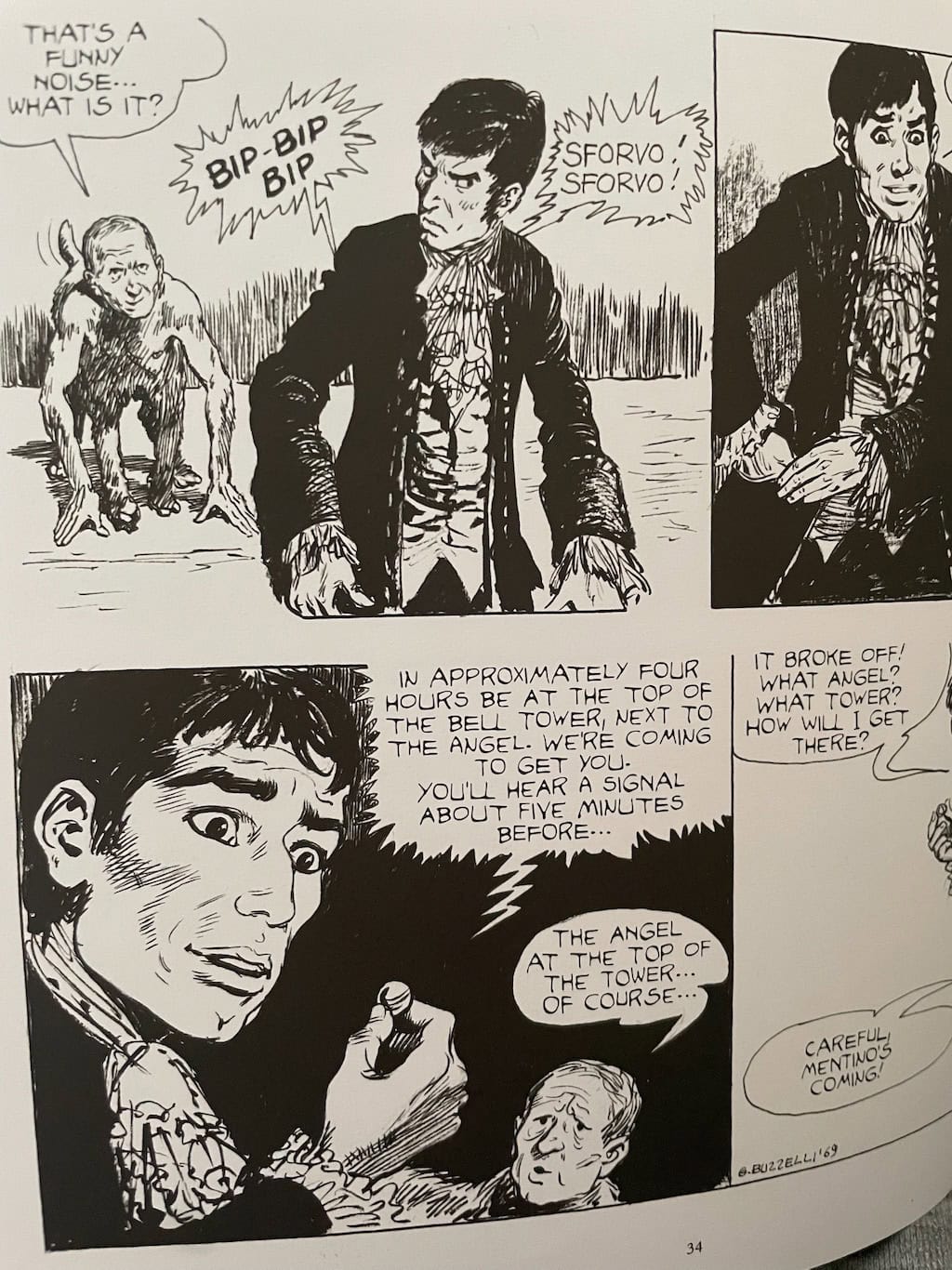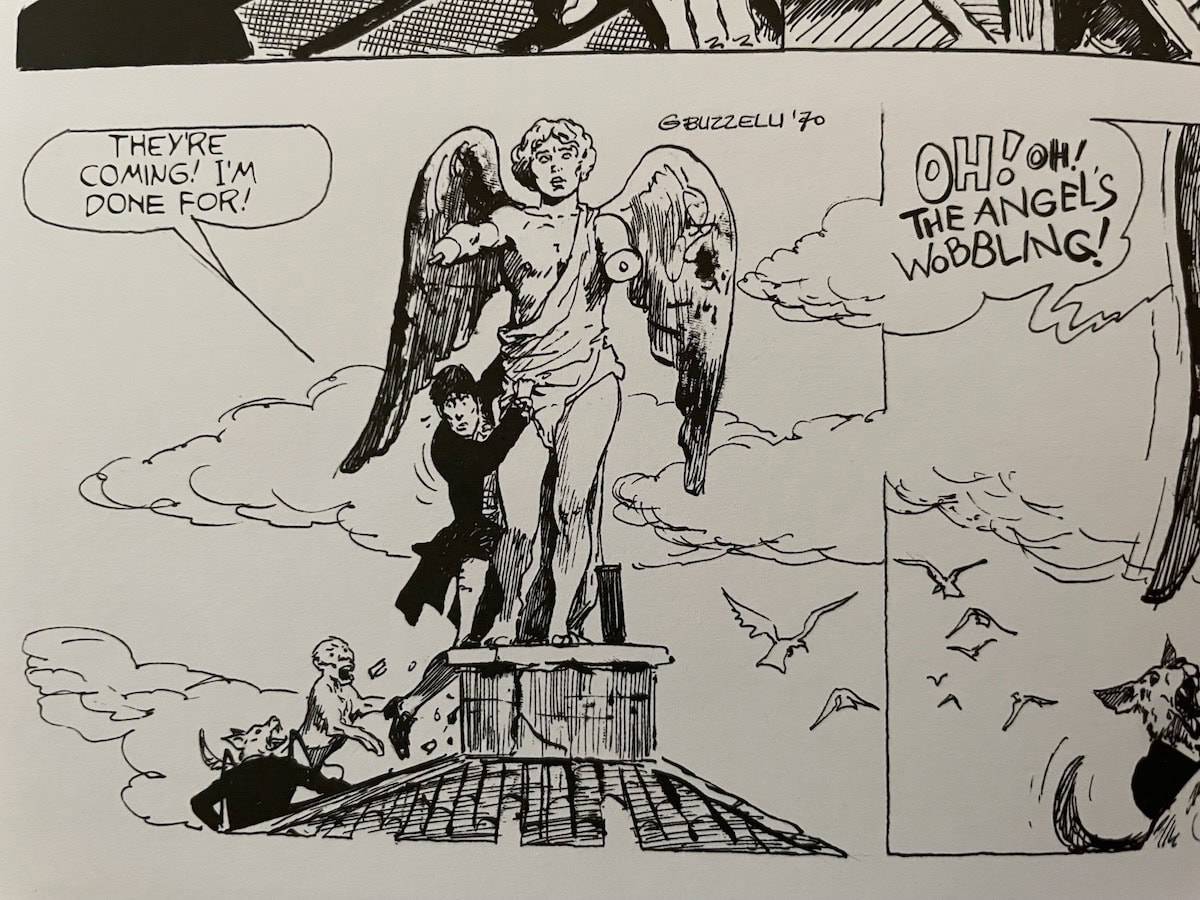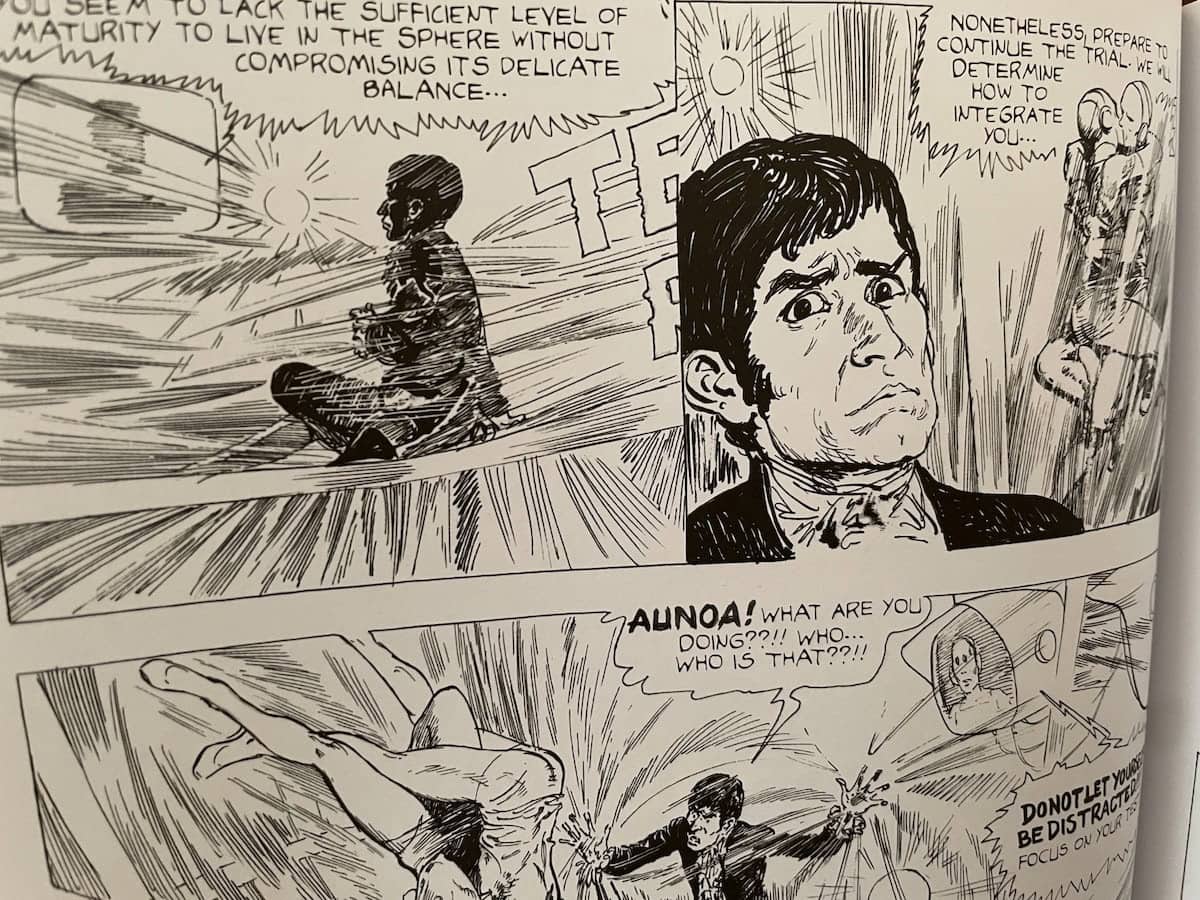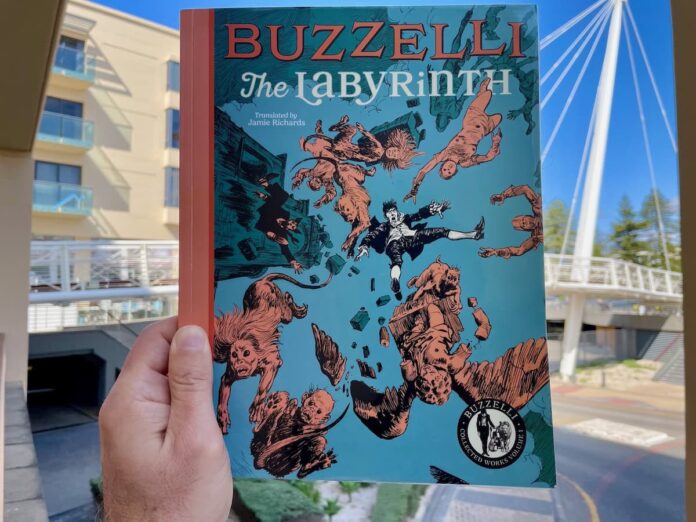In the captivating world of surreal comics, Buzzelli’s “THE LABYRINTH” emerges as a powerful exploration of identity, mythology, and the indomitable human spirit amidst chaos. Prepare yourself for an intriguing journey as this review delves into the wonderfully unexpected intricacies of “The Labyrinth.” This book isn’t for kids — it’s for adults. Just a heads up!
The title alone evokes imagery reminiscent of Greek mythology, hinting at the enigmatic Minotaur — a creature that embodies duality with its half-man, half-bull form. Yet, in a captivating twist, Buzzelli introduces readers to a labyrinthine narrative populated by dog men, evoking new interpretations of the Minotaur’s essence.
The narrative invites readers to explore the complex journey of its protagonist, Marcello Sforvo, who emerges as a contemporary incarnation of Theseus. In this post-apocalyptic landscape, Marcello navigates a labyrinthine world filled with surreal twists and enigmatic challenges, much like the tale found in “Kill the Minotaur.”
Haunted by the specters of a shattered civilization, he must confront not only external dangers but also the shadows of his own psyche, as he seeks to unravel the mysteries of this chaotic realm. Will he emerge victorious, or will he be swallowed by the very maze he seeks to conquer? The story beckons readers to immerse themselves in Marcello’s odyssey, where each turn unveils another layer of intrigue, blurring the line between reality and illusion.
The Labyrinth by Buzzelli: Surreal Comic Review
The story unfolds in the grim aftermath of a catastrophic nuclear event, set against a backdrop of relentless warfare, where the boundary between humanity and savagery becomes increasingly tenuous. In this haunting landscape, Guido Buzzelli (1927-1992) introduces a diverse cast of characters, ranging from ruthless, authoritarian figures reminiscent of historical tyrants such as the Nazis, to the otherworldly Aunoa, an ethereal being embodying hope and transcendence.
Through this intricate mosaic of despair and resilience, Buzzelli weaves a narrative that explores the dark depths of the human experience while illuminating shards of hope that pierce through the gloom. Each character holds a piece of this elaborate tapestry, revealing the complex interplay of fear and aspiration that defines their existence in this perilous world. As the story progresses, readers are drawn into a compelling examination of what it truly means to be human in a time when civilization teeters on the brink of collapse.
Aunoa’s enigmatic origins create suspense, captivating readers with the question: Is she a potential savior or yet another layer of the labyrinth Marcello must traverse?
Steeped in allegory and steeped in rich visual storytelling, THE LABYRINTH transcends typical comic narratives, inviting readers to delve deeper into its layers of meaning. With every turn of the page, the unexpected beckons, keeping readers guessing and engaged.
Buzzelli’s work transcends mere entertainment, emerging as a poignant commentary on the intricacies of the human experience. This remarkable comic invites readers on a journey through a surreal landscape that serves as a mirror to the complexities of existence. It stands out as not only one of the most enjoyable reads but also an intellectually enriching exploration, making it a truly unforgettable experience.
The Labyrinth Review: Story Introduction
Marcello Sforvo, the reluctant hero of Buzzelli’s THE LABYRINTH, navigates a shattered world, burdened by his identity and the traumas of a nuclear aftermath. From the moment he steps into this surreal landscape, readers witness his internal struggles reflected in the distorted reality surrounding him.
In his darkest moments, Marcello encounters Aunoa, the angelic figure who emerges like a beacon of hope amidst desolation. Her arrival is both perplexing and transformative; she embodies light and mystery, whispering promises of salvation while simultaneously challenging Marcello’s understanding of existence.

Their meeting unfolds in a dreamlike sequence that captivates the reader. Aunoa’s ethereal beauty contrasts sharply with the grim surroundings, her presence suggesting that redemption may lie beyond the labyrinth’s monstrous confines. As Marcello grapples with his fears and insecurities, Aunoa offers more than just comfort; she becomes a catalyst for his quest for self-discovery.
Yet, questions linger — is she truly a savior, or does she represent another layer of complexity in Marcello’s already convoluted journey? Their interactions deepen the narrative, blending elements of mythological symbolism with profound emotional resonance. Thus, Marcello Sforvo’s path is illuminated by the enigmatic Aunoa, guiding him through the labyrinth of both the external world and his own psyche.

Yet, as their connection deepens, a palpable tension arises. Aunoa, despite her celestial grace, is burdened by uncertainty regarding Marcello’s worthiness for salvation. This internal conflict adds layers to her character; she is not simply a savior, but a complex being grappling with her own divine judgment. Her hesitation forces Marcello to confront the essence of his being — his fears, his past mistakes, and whether he is truly deserving of redemption.
In a moment laden with poignancy, Aunoa knows she must leave him behind, plunging Marcello into an even deeper abyss of self-reflection. This departure becomes a crucible for his transformation; it ignites a fierce determination within him to prove his worth. The ambiguity of Aunoa’s intentions lingers in the air, exposing Marcello’s vulnerability and fueling his quest through the twisted corridors of the labyrinth.

The Labyrinth Review: Mean Dog Men
Just as Aunoa melts into the shadows, leaving Marcello Sforvo grappling with the weight of her absence, an eerie stillness blankets the landscape. However, tranquility is a fleeting illusion in this world, quickly shattered by the emergence of sinister forces that spiral chaos into Marcello’s already tormented existence.
Almost immediately, from the mist and debris of forgotten dreams, a grotesque creature materializes — a half-dog, half-man abomination, its form a nightmarish blend of loyalty and malevolence. This beast embodies the feral instincts of a predator fused with the cunning of a man. Short fur bristles over sinewy muscles, and its eyes glimmer with a predatory intelligence, blending primal rage with the remnants of twisted humanity.
This fierce-looking creature seems drawn to Marcello not just as a harbinger of doom but as a reflection of his own inner turmoil and darkest instincts. Each growl reverberates like an echo of his fears, the very fragments of himself he is desperate to escape. What does it want? Is it a physical manifestation of the guilt and failures that haunt Marcello, chasing him relentlessly through the labyrinth’s twisting paths? Or is it a guardian of sorts, a relentless force nudging him toward either salvation or ruin?

As Marcello sprints through the labyrinthine corridors, heart pounding and breathless, his journey into hell is just beginning.
The Labyrinth Review: Nazi Themes
In “The Labyrinth” by Buzzelli, Nazi themes of dehumanization and grotesque experimentation are palpably woven into the narrative. Central to this chilling tale are the dogmen — hybrid creatures birthed from cruel human experimentation reminiscent of the Third Reich’s infamous ethics violations. These beings symbolize the ultimate perversion of humanity, echoing the horrific realities of Nazi medical abuses, where the sanctity of life was sacrificed on the altar of twisted ideology.

“The Labyrinth” powerfully illustrates the depths of torture and brutality that evil regimes can inflict, revealing how such atrocities can stem from the decisions of a mere handful of individuals.
Through his masterful storytelling, Buzzelli vividly captures the profound psychological and physical scars borne by the victims, shining a stark light on the moral depravity of a society that allows these horrors to transpire.

In the face of unimaginable adversity, the most rational response for anyone trapped in a dire situation is to seek a way out — an instinct driven by the fundamental human desire for freedom and survival. This is precisely the desperate yet courageous choice that Marcello Sforvo made. His determination to escape not only illustrates the depths of his resilience but also serves as a testament to the indomitable spirit of those who refuse to be subdued by their circumstances.

Sforvo’s journey encapsulates the struggle between hope and despair, as he navigates a treacherous landscape fraught with obstacles and dangers at every turn. His story is not just about the act of fleeing; it embodies the universal quest for liberation and the lengths to which one will go to reclaim their autonomy.
In a world where oppression reigns, Sforvo’s efforts remind us of the inherent human impulse to seek refuge and restoration, making his quest for freedom not just a personal battle, but a larger commentary on the resilience of the human spirit.
However, Mr. Sforvo’s daring attempt at escape ultimately leads to his capture by the very entities that epitomize the horrors of his predicament—the dog men. These once-human beings, grotesquely transformed into monstrous figures, serve as a chilling reminder of the brutal machinations of the regime that unleashed their torment.

The dog men are not simply mindless beasts; they are tragic figures, victims of a cruel system that dehumanized them, stripping away their identities and replacing them with savage instincts. This transformation underscores the insidious nature of tyranny, which not only corrupts the oppressor but also ravages the souls of the oppressed, converting them into instruments of fear and control.
As Sforvo confronts these creatures, the encounter becomes a poignant reflection on the fragility of humanity in the face of overwhelming evil. His perilous situation prompts a deeper introspection — not only about his own fate but also about the tragic loss of humanity that the dog men embody. This collision of hopes and horrors accentuates the theme of survival against the darkest aspects of both individual and collective experience, reminding us that within every villain lies a story of anguish and lost potential.
The Labyrinth: Finding Salvation
In the end, Sforvo’s struggle is not merely against physical captivity, but against the very forces that threaten to extinguish the light of what it means to be human. But even some dog men still have some good left in them.

Among the ranks of the dog men, one stands out — an enigmatic figure known as “Engineer.” Unlike his fellow captors, who revel in their monstrous forms and twisted existence, Engineer embodies a flicker of humanity that the others have long since abandoned. Deep within, he harbors the scars of his own suffering and a profound empathy for those who could share his fate, particularly Marcello.
Despite the oppressive atmosphere that surrounds him, Engineer is determined to prevent Marcello from experiencing the same disastrous path he was forced to tread. With a careful blend of caution and compassion, he devises a plan to clandestinely assist Marcello, hoping to steer him toward a glimmer of hope amidst the despair. His intentions, however, are not without their subtleties; before helping him to escape, Engineer yearns to provide Marcello with a tour of the Labyrinth — a twisted maze that serves as both prison and stage for the dark entertainment of their captors.

As they navigate the foreboding corridors, Engineer points out various grotesque spectacles that unfold within the Labyrinth, each one a stark reminder of the madness that has consumed both captors and captives. He showcases oddities that make up the disturbing ecosystem of the Labyrinth — rooms filled with eccentric contraptions, bizarre performances showcasing the grotesque interplay between man and beast, and echoes of laughter that ring hollow among the shadows.

Through this tour, Engineer hopes to forge a bond of trust and understanding. Beneath his monstrous exterior, Engineer longs for connection and the rekindling of a shared humanity. His actions embody a quiet rebellion against the fate imposed upon them, a seed of resistance planted in the heart of a soul determined to protect another from the darkness that had claimed his own.

And in the labyrinthine twists of their world, the two may just discover a path that transcends their despair, leading them toward a semblance of hope and freedom.
Angels of the Great Sphere: The Heavenly Realm
In the final act of “The Labyrinth,” Marcello finds himself drawn toward the elusive Great Sphere, a realm that promises salvation and an escape from the horrors of his earlier trials. Initially, he views it as a beacon of hope — a paradise where the pain and suffering of his past could be forgotten, replaced by an existence bathed in light and tranquility. With the ethereal guidance of his angel, Aunoa, her luminous presence instilling a renewed sense of purpose within him.
However, as Marcello crosses into this supposedly heavenly realm, the truth begins to unravel slowly, revealing that the Great Sphere is as beguiling as it is sinister. The landscapes are adorned with breathtaking beauty, yet shadows lurk just beneath the surface, whispering secrets of despair and manipulation.

As he attempts to anchor himself within this realm, he finds that lingering there comes at a steep price. The allure of the Great Sphere whispers promises of eternal comfort, yet looming overhead is the constant threat of slipping back into the nightmarish grasp of the Labyrinth.
Aunoa’s ethereal guidance, once a source of clarity, becomes increasingly fraught with ambiguity as Marcello struggles to maintain his grip on this transient sanctuary. Each moment spent in the Great Sphere tests not only his resolve but also the very essence of what it means to be free.
In a journey of self-discovery, Marcello delves into the dichotomy of light and dark, confronting the complexities of hope and fear interwoven in the fabric of his existence. This realm, once painted as a sanctuary, forces him to grapple with uncomfortable truths about the nature of salvation and the price of residing in a place that feels more like a gilded cage than an open sky.
As Marcello navigates the trials of this celestial haven, he comes to understand that true strength lies not in escapism but in facing the shadows within and without. The Great Sphere becomes a crucible — a place where the resilience of his spirit is tested against the very ideals for which he has fought. And amidst the intricate web of dreams and nightmares, he discovers that the most profound battles are often waged not against external forces, but within the depths of one’s own soul.
To uncover the fate of Marcello in the Great Sphere, and to truly appreciate the intricate layers of this remarkable narrative, one must journey through “The Labyrinth” for themselves. The revelations awaiting within its pages promise to be an unforgettable exploration of human resilience and the ever-shifting meaning of hope.
Buzzelli’s The Labyrinth: Review Conclusion
In conclusion, “The Labyrinth” by Buzzelli is a stunning surreal comic that captivates from start to finish. This compelling narrative draws readers into a richly woven tapestry of vivid imagery and thought-provoking metaphors, making it an unforgettable reading experience. The story’s complexity reflects the intricacies of the human condition, effortlessly marrying fantasy with deep philosophical questions.
Buzzelli’s artistic style enhances the immersive journey through his bizarre yet mesmerizing world. Each panel bursts with detail, inviting readers to linger and explore every nuance. The characters, particularly Marcello and his angel Aunoa, evoke empathy and provoke introspection, forcing us to confront our own fears and desires as they navigate their harrowing experiences in the Great Sphere and the Labyrinth.
What sets “The Labyrinth” apart is its ability to engage multiple levels of interpretation, rewarding readers with new insights. The weight of its themes and the brilliance of its execution make it a must-read for anyone seeking literature that challenges and inspires.
This surreal comic is not only a narrative triumph but also an artistic masterpiece that will resonate with anyone who dares to explore its depths. Don’t miss out on the chance to dive into Buzzelli’s extraordinary vision — grab your copy of “The Labyrinth” today and embark on a journey you won’t soon forget!
I’m giving Buzzelli’s “The Labyrinth” a solid 9 out of 10. I was pleasantly surprised by just how much I enjoyed it, especially considering it’s presented in black and white. This stylistic choice enhances the story’s bleakness and lends it a haunting quality that lingers long after you turn the last page. Overall, it’s an incredible read that I highly recommend!
This totally unique comic from an Italian master transcends the boundaries of the surreal, conjuring echoes of Apollo’s Song while plunging readers into a far more harrowing abyss. “THE LABYRINTH” invites you into a nightmarish realm where shadows twist and reality unravels — an unsettling place that no soul would ever wish to stumble upon.
Faced with the choice between confronting the legendary Minotaur or the terrifying dogmen that roam its winding corridors, it becomes chillingly clear: the monstrous Minotaur, with its brute strength and primal fury, might just seem like the more merciful option. Welcome to “THE LABYRINTH,” where every step forward invites unimaginable horrors and despair lurks in every corner. Which nightmare will you choose?
Check Availability & Pricing: Buzzelli Collected Works Vol. 1: The Labyrinth
Pin it … Share it






